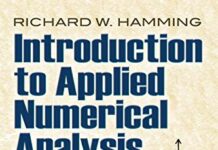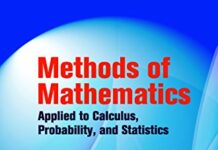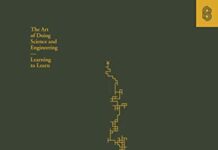
Ebook Info
- Published: 2018
- Number of pages: 364 pages
- Format: PDF
- File Size: 3.44 MB
- Authors: Richard W. Hamming
Description
Offering accessible and nuanced coverage, Richard W. Hamming discusses theories of probability with unique clarity and depth. Topics covered include the basic philosophical assumptions, the nature of stochastic methods, and Shannon entropy. One of the best introductions to the topic, The Art of Probability is filled with unique insights and tricks worth knowing.
User’s Reviews
Reviews from Amazon users which were colected at the time this book was published on the website:
⭐When a scientist is really great we forget his name and use it as an ordinary technical term. Such as when we say the hamming distance between two character strings. Yes, this is the same R. W. Hamming, author of this beautiful book. I really wish I had this treasure back then, when I was taking my probability course at the university (around 1996). I admired Hamming’s approach to subjects as an engineer. I say as an engineer, because the book can seem a little bit strange to a mathematician who expects axioms and then theorem proofs. It does have some proofs but only where author thinks they are obligatory. He presents many intricate concepts with very critical and valuable insights and concentrate on the methods to use various problems in probability. Not only how to solve it but why to solve it that way. The author is also very careful to draw attention to the pitfalls that one may encounter in this strange and beautiful journey, which makes the book only more valuable. For the statisticians: This is not a statistics book but one book that you owe yourself to have on your bookshelf.
⭐Some noted mathematicians and scientific theorists are great teachers and writers, others not. Hamming was one of the former and this is a fine book. It is the one book I grab when I want to understand anything about probability and its applications. Not only does it cover a wide range of probability related topics, but it also discusses philosophical and working assumptions in depth with great humor and insight.I wish that I had known of this book when I was in graduate school. However, it has even more use for a practitioner or teacher than for a first time student, as it gives one new insights with each reading of the material.One thing, when Hamming says to go and “work it out” to gain insight, take him at his word and go at it. He knew his stuff and you will too if you spend some serious time with this text.
⭐This review applies only to the Kindle ebook. It has the worst typesetting I’ve ever seen. Mathematical expressions are either bitmapped, misaligned, blurry, and more than twice the size of the text, or else they’re set in type half the size of the text and out of position on the page. I’ll think long and hard about ever buying another scientific book in this format.
⭐This book is very well written and it help me understand the beauty of probability, which is in fact an art.
⭐In a lot of ways in this book Hamming does for probability what Feynman did for physics in his lectures. He gives a passionate and ingenious introduction to probability theory as he sees it, using seemingly quite elementary mathematical methods, often though in intricate ways. The approach is unique and I think unseen anywhere else: Hamming develops a sequence of models of probability, starting from the simplest where symmetry is the source of the probability, then proceeding to discrete sample spaces and a frequency-based interpretation of probability, finally ending up with continuous sample spaces. Unlike in most other books, every model is motivated before it is introduced, for example the law of large numbers is discussed early, and until this point only problems involving symmetry based probability appear, so that there is plenty of substantiation for each model before problems are worked through.There are many other unique things in this book, for example Hamming discusses sensitivity of particular probabilistic methods to small pertrubations of the initial probabilities, and many other similar potential tricky issues with practical applications of probability theory. Hamming worked at Los Alamos, and I think he understood better than most mathematicians the consequences mathematical considerations can yield, and this shows in those careful discussions of modelling issues scattered throughout the book, I would go as much as to say he is trying to instill some sense of social responsibility in you. Another interesting difference from the typical modern probability textbook is heavy use of generating functions in many places throughout the book. Hamming is also strong in developing intuition, for example there are many numerical tables showing numerical results of sample probability experiments, which is another thing about this book that reminded me of the Feynman lectures – typical math and physics book somehow avoid this type of numerical work.As for disadvantages, the book doesn’t cover all the subjects modern textbooks cover, especially the discussion of continuous sample spaces is rather brief. Some terminology is atypical, for example Markov chains are treated in the book, but they are called simply “state diagrams”. Exercises only have numerical answers, and those immediately follow the text of the exercise, so you can only start the exercise with answer already in mind. Again, as in case of the Feynman lectures, Hamming can be incredibly clever sometimes, to the point it’s hard to follow his train of thought. At places also more advanced mathematics appears (but some calculus is more than enough for most of the book). I think this book will work for you best if you supplement it, like I did, with one of the traditional, classroom-proven probability books – the Bertsekas/Tsitsiklis one or one by Sheldon Ross. Despite those disadvantages, I can’t rate this book any lower than 5 stars, since the coverage of this book is so unique and the material not to be found anywhere else.
Keywords
Free Download The Art Of Probability 1st Edition in PDF format
The Art Of Probability 1st Edition PDF Free Download
Download The Art Of Probability 1st Edition 2018 PDF Free
The Art Of Probability 1st Edition 2018 PDF Free Download
Download The Art Of Probability 1st Edition PDF
Free Download Ebook The Art Of Probability 1st Edition




